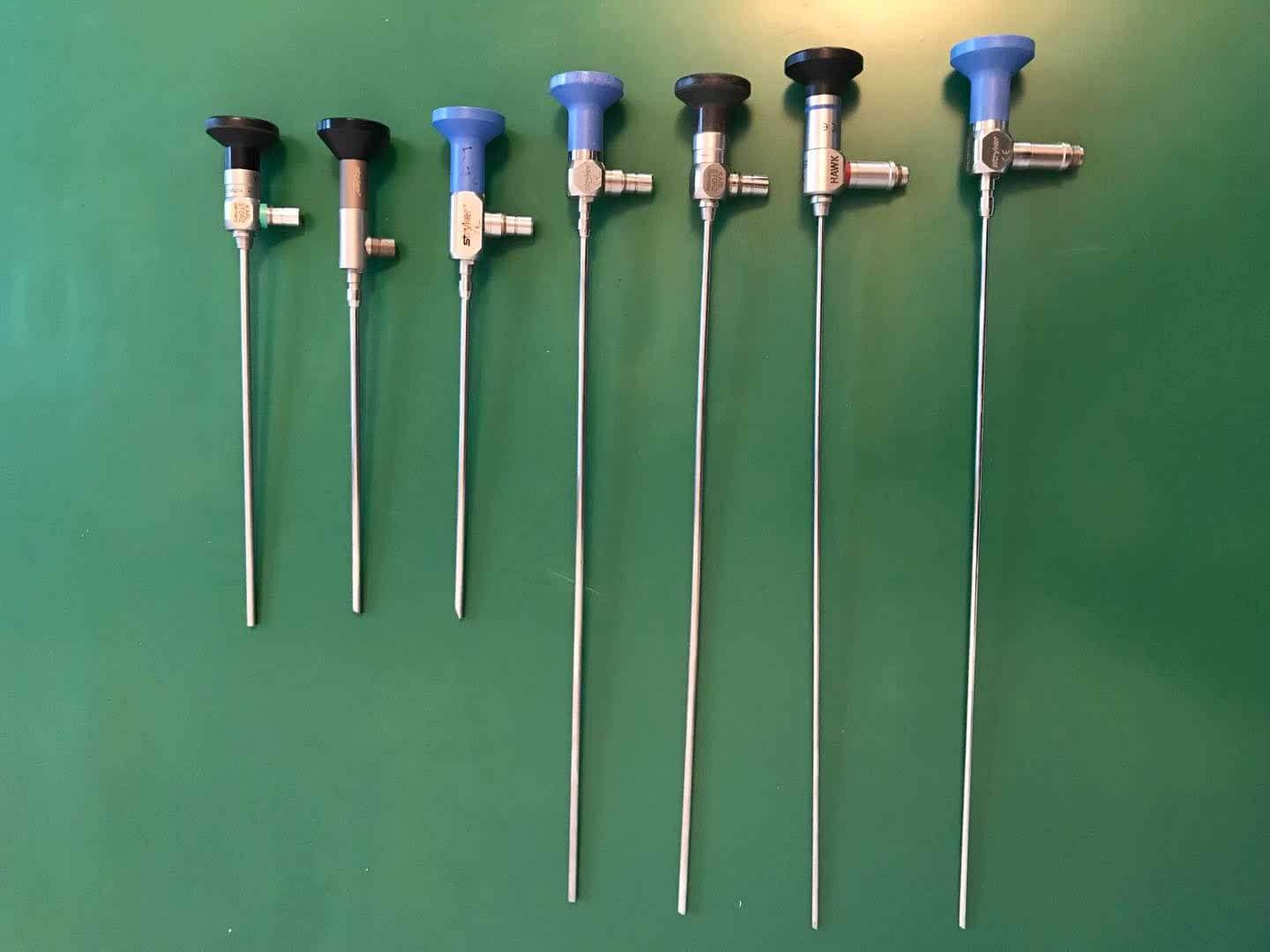歡迎來到匠仁醫療設備有限公司網站!


電子內窺鏡與纖維內窺鏡作為現代醫學與工業檢測的核心工具,其維修技術路線因結構原理差異呈現顯著區別。電子內窺鏡以電荷耦合器件(CCD)或互補金屬氧化物半導體(CMOS)為成像核心,通過數字信號傳輸圖像,而纖維內窺鏡依賴數萬根光纖束傳導光學信號。這種本質差異直接決定了兩者在故障診斷、部件更換及維護周期上的不同策略。
Electronic endoscopes and fiber endoscopes, as the core tools of modern medicine and industrial testing, show significant differences in their maintenance technology routes due to differences in structural principles. Electronic endoscopes use charge coupled devices (CCD) or complementary metal oxide semiconductors (CMOS) as imaging cores to transmit images through digital signals, while fiber endoscopes rely on tens of thousands of fiber bundles to conduct optical signals. This fundamental difference directly determines the different strategies of the two in fault diagnosis, component replacement, and maintenance cycles.
成像系統維修的復雜性對比
Comparison of Complexity in Imaging System Maintenance
電子內窺鏡的圖像傳感器位于先端部,與主機通過精密線束連接。維修時需用示波器檢測信號輸出穩定性,若出現噪點或色偏,需排查傳感器芯片級焊點虛焊或線束斷裂。以某主流機型為例,其柔性電路板(FPC)厚度僅0.2毫米,維修需在百級凈化間使用激光焊接設備,操作誤差需控制在±0.05毫米以內。相比之下,纖維內窺鏡的故障多集中于光纖束斷裂或透鏡組移位,維修時需通過光纖顯微鏡定位斷點,采用熱熔接技術逐根修復,單根光纖修復成功率不足70%,通常需整體更換光纖束。
The image sensor of the electronic endoscope is located at the tip and connected to the host through a precision wire harness. During maintenance, it is necessary to use an oscilloscope to check the stability of the signal output. If there is noise or color deviation, it is necessary to investigate the sensor chip level solder joints for virtual soldering or wire harness breakage. Taking a mainstream model as an example, its flexible circuit board (FPC) thickness is only 0.2 millimeters, and maintenance requires the use of laser welding equipment in a Class 100 purification room, with operational errors controlled within ± 0.05 millimeters. In contrast, the faults of fiber endoscopes are mostly concentrated in fiber bundle breakage or lens group displacement. During maintenance, the breakpoint needs to be located through a fiber optic microscope and repaired one by one using thermal fusion technology. The success rate of repairing a single fiber optic is less than 70%, and the fiber bundle usually needs to be replaced as a whole.
機械結構維護的側重點差異
Differences in emphasis of mechanical structure maintenance
電子內窺鏡的插入管內置蛇骨關節,通過四根鋼絲牽引實現彎曲控制。鋼絲疲勞斷裂是常見故障,更換時需專用張緊校準裝置,確保彎曲角度誤差≤2°。而纖維內窺鏡的機械磨損主要集中在導光束接口,需定期清潔并涂抹硅基潤滑劑,防止光纖端面劃傷。兩者在防水密封處理上均采用生物相容性膠水,但電子內窺鏡因集成電子元件,需進行氣密性檢測,壓力值需維持在15kPa下30分鐘無泄漏。
The insertion tube of the electronic endoscope is equipped with a snake bone joint, which is controlled for bending through the traction of four steel wires. Fatigue fracture of steel wire is a common fault, and a dedicated tension calibration device is required for replacement to ensure that the bending angle error is ≤ 2 °. The mechanical wear of fiber endoscopes is mainly concentrated at the light guide interface, which needs to be cleaned regularly and coated with silicon-based lubricants to prevent scratches on the fiber end face. Both use biocompatible adhesives for waterproof sealing treatment, but electronic endoscopes require airtightness testing due to the integration of electronic components, and the pressure value needs to be maintained at 15kPa for 30 minutes without leakage.

光源與光學系統的維修路徑
Repair path for light source and optical system
電子內窺鏡多采用LED冷光源,壽命可達10000小時以上,故障率低于5%。當出現亮度衰減時,需檢測驅動電路恒流模塊參數,而非直接更換光源。纖維內窺鏡則依賴外部氙燈或鹵素燈,燈泡壽命僅500-1000小時,更換時需同步校準光斑均勻度,避免灼傷光纖。光學鏡頭方面,電子內窺鏡的物鏡鍍膜層數達20層以上,清潔時需使用異丙醇與無塵布,禁用含氯溶劑;纖維內窺鏡的透鏡組清潔相對簡單,但需警惕發霉風險,潮濕環境需配備干燥裝置。
Electronic endoscopes often use LED cold light sources, with a lifespan of over 10000 hours and a failure rate of less than 5%. When brightness attenuation occurs, it is necessary to detect the parameters of the constant current module in the driving circuit, rather than directly replacing the light source. Fiber endoscopes rely on external xenon or halogen lamps, with a bulb lifespan of only 500-1000 hours. When replacing, it is necessary to calibrate the uniformity of the light spot synchronously to avoid burning the optical fiber. In terms of optical lenses, the coating layer of the objective lens of electronic endoscopes should be more than 20 layers. Isopropanol and dust-free cloth should be used for cleaning, and chlorine containing solvents are prohibited; The cleaning of the lens group of the fiber endoscope is relatively simple, but caution should be taken against the risk of mold, and a drying device should be equipped in humid environments.
維修成本與周期的量化分析
Quantitative analysis of maintenance costs and cycles
以某三甲醫院設備科數據為例,電子內窺鏡年度維修成本中,傳感器更換占比45%,線束維修占30%,機械部件占25%,單次大修平均費用約合設備原值的15%。纖維內窺鏡的維修成本則集中在光纖束更換(60%)和光源維護(25%),單次維修周期通常為電子內窺鏡的1.5倍。值得注意的是,電子內窺鏡的預防性維護可延長使用壽命3-5年,而纖維內窺鏡因光學衰減特性,建議每2年進行性能評估。
Taking the equipment department data of a tertiary hospital as an example, in the annual maintenance cost of electronic endoscopes, sensor replacement accounts for 45%, wire harness maintenance accounts for 30%, mechanical components account for 25%, and the average cost of a single major overhaul is about 15% of the original value of the equipment. The maintenance cost of fiber endoscopes is concentrated in fiber bundle replacement (60%) and light source maintenance (25%), with a single maintenance cycle typically 1.5 times that of electronic endoscopes. It is worth noting that preventive maintenance of electronic endoscopes can extend their service life by 3-5 years, while fiber endoscopes are recommended to undergo performance evaluations every 2 years due to their optical attenuation characteristics.
技術演進對維修的影響
The impact of technological evolution on maintenance
隨著4K超高清電子內窺鏡的普及,維修領域正引入AI輔助診斷系統,通過圖像分析預測傳感器性能衰減趨勢,提前3個月預警故障。纖維內窺鏡則通過復合光纖技術提升耐用性,新型塑料光纖束的抗彎折次數從傳統玻璃光纖的500次提升至2000次。這些技術革新正在重塑維修策略,推動從被動維修向主動維護轉型。
With the popularity of 4K ultra high definition electronic endoscopes, AI assisted diagnostic systems are being introduced in the maintenance field to predict sensor performance degradation trends through image analysis and provide early warning of faults three months in advance. Fiber endoscopes improve durability through composite fiber optic technology, and the bending resistance of new plastic fiber bundles has been increased from 500 times for traditional glass fibers to 2000 times. These technological innovations are reshaping maintenance strategies and driving the transition from passive maintenance to active maintenance.
理解電子內窺鏡與纖維內窺鏡的維修差異,需從成像原理、機械結構、光源系統三維度綜合考量。醫療機構與檢測單位應根據設備類型建立差異化維護體系,結合制造商技術文檔制定檢修周期,方能在保障檢測精度的同時控制全生命周期成本。
Understanding the maintenance differences between electronic endoscopes and fiber endoscopes requires a comprehensive consideration of imaging principles, mechanical structures, and three-dimensional light source systems. Medical institutions and testing units should establish differentiated maintenance systems based on equipment types, and develop maintenance cycles in conjunction with manufacturer technical documents, in order to control the entire lifecycle cost while ensuring testing accuracy.
本文由內窺鏡設備維修友情奉獻.更多有關的知識請點擊:http://www.cnxgtzyj.cn我們將會對您提出的疑問進行詳細的解答,歡迎您登錄網站留言.
This article is a friendly contribution from the maintenance of endoscopic equipment For more information, please click: http://www.cnxgtzyj.cn We will provide detailed answers to your questions. You are welcome to log in to our website and leave a message
 公司:匠仁醫療設備有限公司
公司:匠仁醫療設備有限公司 樊經理:13153199508 李經理:13873135765
公司地址:山東省濟南市槐蔭區美里東路3000號德邁國際信息產業園6號樓101-2室 湖南省長沙市雨花區勞動東路820號恒大綠洲14棟2409室
備案號:魯ICP備2023027194號-1 魯公網安備 37010402441281號